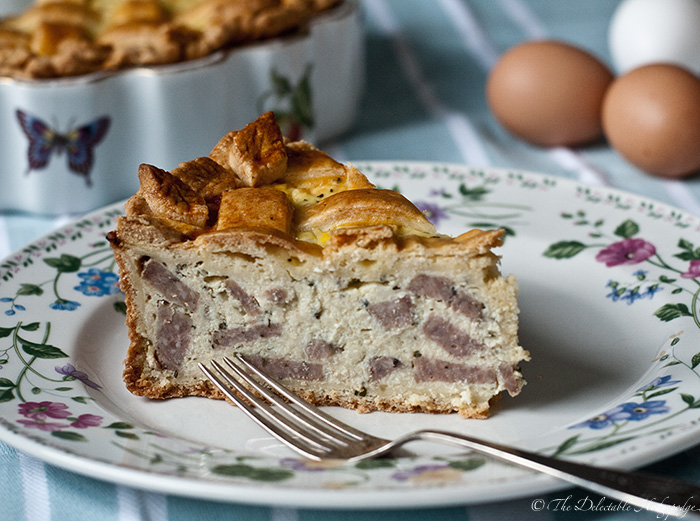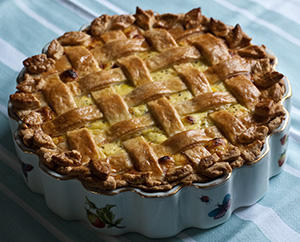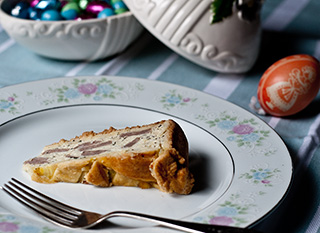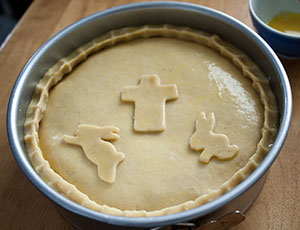
Grandma Carosella’s Easter Pie
| Ingredient | 9-inch Pie | 23cm Pie |
|---|---|---|
| Crust | ||
| flour | 2 cups | 280g |
| sugar | 2 Tbsp. | 2 Tbsp. |
| baking powder | ½ Tbsp. | ½ Tbsp. |
| salt | ½ tsp. | ½ tsp. |
| fresh ground pepper | liberal, to taste | liberal, to taste |
| butter | ¼ pound (1 stick) | 113g (1 stick) |
| eggs | 2 large | 2 large |
| Glaze | ||
| egg yolk | 1 | 1 |
| water | 1 tsp. | 1 tsp. |
| Filling | ||
| Italian hot sausage | 1 pound | 450g |
| ricotta cheese | 1½ pounds | 680g |
| eggs | 4 large | 4 large |
| Parmesan, grated | ½ cup | ½ cup |
| mozzarella, shredded | 2 heaping cups (8 oz.) | 2 heaping cups (220g) |
| dried basil | 1 Tbsp. | 1 Tbsp. |
| parsley (dried or fresh) | 1 Tbsp. | 1 Tbsp. |
| fresh ground pepper | to taste | to taste |
This pie, properly called Torta Pasqualina, or Easter Pie, comes from an Old Country recipe handed down from Agnone, Italy through my grandmother, Erma Slota. Rich and heavy, but not overpoweringly flavored, we traditionally ate it at Easter brunch, but there’s no need to limit it to that role or season; it can serve equally well as a substantive midmorning or afternoon meal, or a side dish fit for any feast.
This version has had only a few modern tweaks added, in particular a bit more technique to keep the crust light and crumbly, and the favorite centerpiece of the Italian half of my family’s kitchen, the food processor.
Preparation

- Cut the butter into half-inch (1cm) cubes and put it in the freezer to chill.
- If using sausage that isn’t pre-cooked, skin sausage links and cook over medium heat, with a little water, until browned. Remove from pan, cool until easy to handle, and slice into quarter-inch (5mm) pieces.
- If using fresh parsley, chop finely.
- Preheat oven to 350°F (180°C).
Directions
- Mix crust ingredients.
Put the dry ingredients for the crust in a food processor beaker and process for several seconds, until mixed and a little fluffy. Add chilled butter cubes and process in pulses until more or less evenly mixed but still very crumbly; be careful not to overdo it. Add two eggs and process until a ball begins to form, but is still crumbly. - Finish mixing and chill dough.
Gather the ball and any stray bits by hand and put it in a medium bowl. Press down with a fist into the top of the ball to flatten it out somewhat. Cut in half, lay the two halves on top of each other, and press again. Repeat this three or four times until it holds together, but don’t knead it — it will become tough if you do. Wrap the ball tightly in plastic wrap and refrigerate. - Mix and process ingredients for filling.
Crack four eggs into the food processor beaker and process for a few seconds, until well scrambled but not fluffy. Add ricotta, mozzarella, and grated Parmesan cheeses, and herbs, and process just until well mixed. Transfer to a bowl and fold in sausage slices. - Shape crust and fill.
Divide the chilled dough into two pieces, with a little more than half for the bottom crust; re-wrap the smaller piece and put it back in the refrigerator while you’re working on the bottom. Roll out the larger half on a floured work surface to fit a large, deep pie dish (or other oven-safe dish). Press crust into pan and pour in filling. - Make top.
Roll out the remaining half of the dough into a circle a little larger than the pie dish. Cover with plastic wrap and return to the refrigerator for five or ten minutes to chill. Cut into ten roughly half-inch (1.5cm) strips and weave them into a decorative lattice on top. Shape any extra bits into leaves or other decorations for the top. - Glaze and bake.
Mix the egg yolk and water for the glaze, then paint it on any exposed dough. Bake at 350°F (180°C) for about 1 hour 15 minutes, until browned and a stick inserted in the custard comes out clean. Serve in thin slices warm or at room temperature.
Notes
-
 While you can of course serve a big chunk, the pie is traditionally sliced quite thin (you can of course have several). It also needn’t be sliced from the middle out, like a regular pie; it’s perfectly acceptable to cut it crosswise into even rectangles starting from one end. You can, in fact, make it in a square or rectangular dish, if a sufficiently deep round dish isn’t handy.
While you can of course serve a big chunk, the pie is traditionally sliced quite thin (you can of course have several). It also needn’t be sliced from the middle out, like a regular pie; it’s perfectly acceptable to cut it crosswise into even rectangles starting from one end. You can, in fact, make it in a square or rectangular dish, if a sufficiently deep round dish isn’t handy. - Though you can of course use any sort of sausage, hot Italian sausage is traditional, and provides the appropriate kick. It is also traditionally made with quite a bit of pepper, though can be toned down if that’s not your thing.
 Keep in mind that if you use a standard 9-inch springform pan, the pie will not fill it to the top, as you can see in the photo at right.
Keep in mind that if you use a standard 9-inch springform pan, the pie will not fill it to the top, as you can see in the photo at right.- When making the crust, it’s very important not to over-process it, either in the food processor or when you’re folding it by hand; if you do, the crust can get very tough.
- If you use a solid sheet for the top instead of a lattice, you should poke plenty of vent holes in it with a toothpick.
- Although it won’t ruin it to use low-fat ricotta for the filling, it’s going to taste better with whole-milk cheese.
